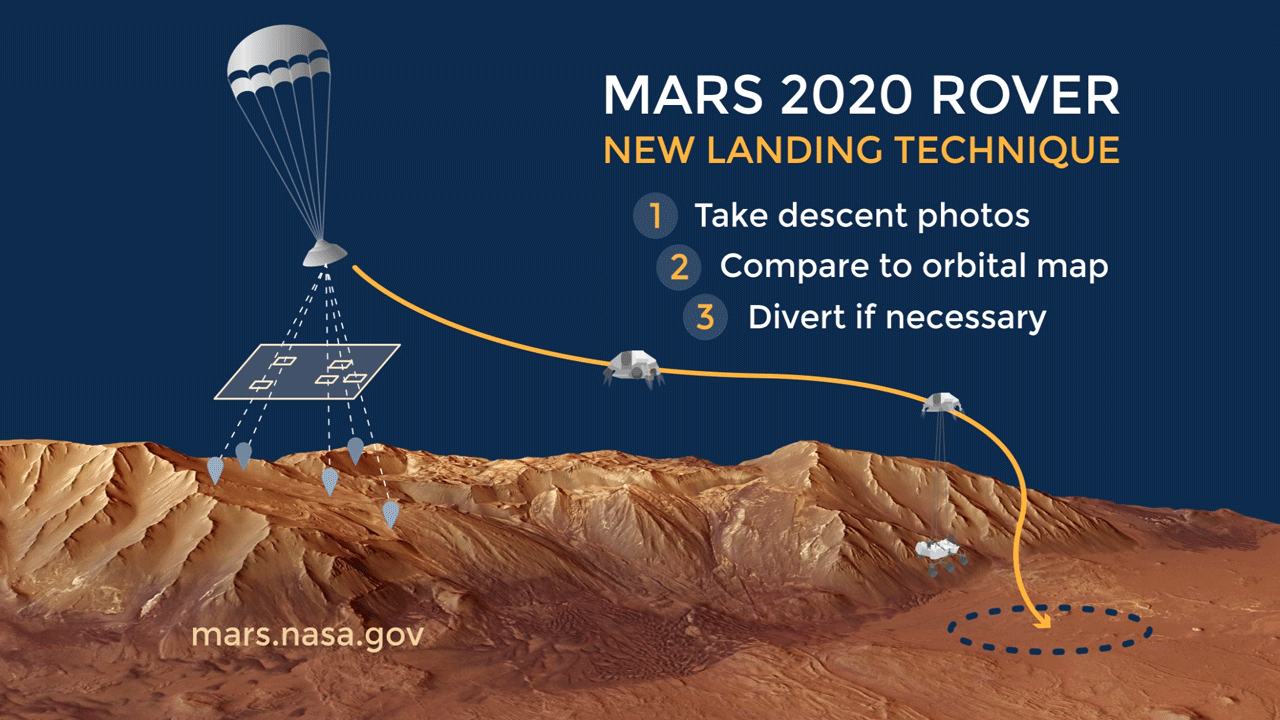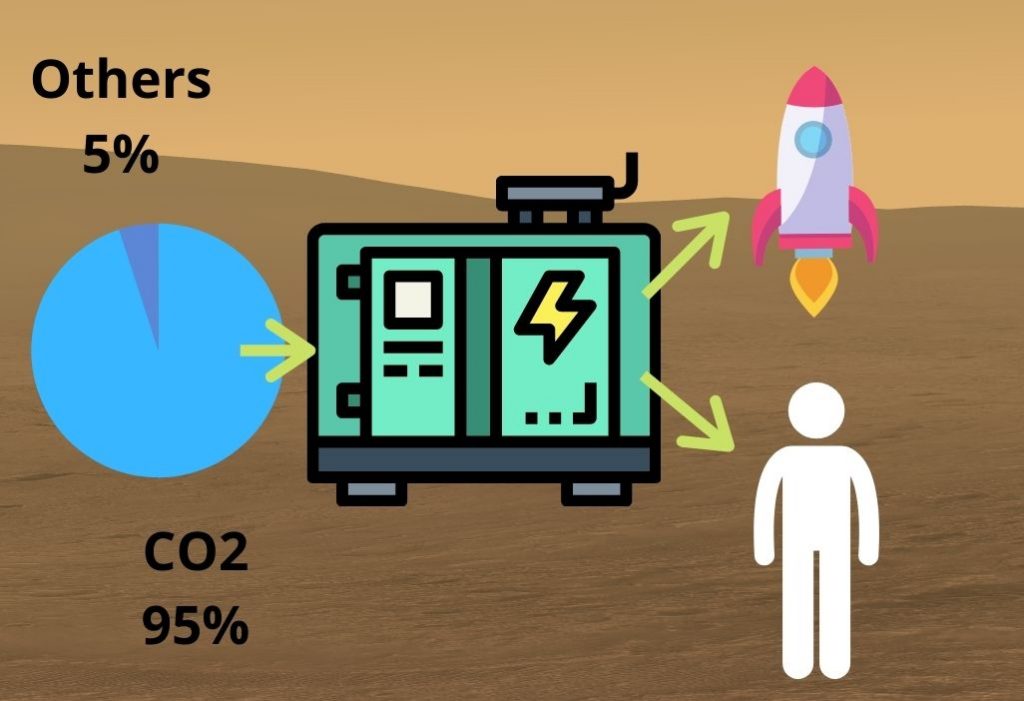At 3:55 p.m., February 18 (time in California, UTC-8), the fact that Perseverance has touched down safely is announced, after a 203-day travel of almost 300 million miles (472 million kilometers). What did Perseverance experience and what will it do in the future? Let’s find out.
The Landing
Other than the usual sky crane maneuver that had happened years ago, Perseverance brought some technology that has never been used on Mars!
Terrain-Relative Navigation
Of course, the landing of this rover is the “Seven minutes of terror“. That’s because it literally takes just 7 minutes to arrive on the surface of Mars from the top of the Martian atmosphere. Its landing site is Jezero Crater, which contained water in the past. However, it also has very complex terrain, making landing very difficult. That’s why NASA used a technology called Terrain-Relative Navigation.
It takes photos of the Martian landscape when it descends, and compares it to the map by the orbiters. Then, if the terrain is too dangerous to land, the rover will divert to a safer spot. “This is finally like landing with your eyes open”, said Swati Mohan, the guidance, navigation, and control operations lead of the Mars 2020 mission, in a YouTube video from the Jet Propulsion Laboratory. With that technology, it will know its direction, not landing without a compass and a map.

Image Credit: NASA
Range Trigger
After all, the Perseverance mission is for exploring past signs of life, right? Well, the landing needs to be very precise. Otherwise, the rover won’t get to the most fascinating spot in its lifetime! Therefore, to nail that task, the rover utilizes Range Trigger. That means the rover has to get the right time to deploy the parachute by measuring its location and velocity, not solely on its speed.
So, this technology helps the landing ellipse to shrink, getting the rover in an interesting area right away. For instance, if the rover is going to land before it arrives at the target, it will decelerate by the parachute later: Oppositely, if the space probe is overshooting the optimal landing zone, it will deploy the parachute earlier.
Cameras and Microphones
Perseverance even brought 6 cameras and a microphone to record the entry, descent, and landing.
Cameras are distributed in the backshell, descent stage, and the rover. Firstly, the 3 cameras looking up from the protective shell captures of the deployment of the parachute. Next, the camera on the descent stage photographs the sky crane maneuver, in which the rover and the descent stage separates to prevent dust from kicking into sensitive components. The camera looking up from the rover also has the same function. Finally, the camera looking down from the rover records the progress of the landing.
NASA has already released a photo taken by the descent stage during the sky crane maneuver. Hopefully, they will receive more photos from Perseverance’s EDL in the future.

Image Credit: NASA
Those cameras and the microphone can have a bird’s-eye view for the entire 7 minutes of terror, hopefully helping the engineers know more about the conditions that future landers may receive on upcoming Mars missions.
The Confirmation of a Safe Touchdown
Well, how do the controllers know that their spacecraft landed safely? Well, they monitored the progress of the Mars landing, from the cruise stage separation to the landing. The EDL (Entry, descent, and landing) process even has its own team, which took over 40 minutes before touchdown.
Moreover, after the touchdown signal, the rover sent two pictures of the terrain in front of itself, meaning that the rover’s cameras are still working fine.
Perseverance’s Future
After applying those new technology, Perseverance safely landed and touched down on Mars. Do you think automating the landing even more can lead to more accurate results? Let us know in the comments. Anyway, the landing is over, so let’s talk about the surface operations.
MOXIE (Mars Oxygen In-Situ Resource Utilization Experiment)
When humans set off to Mars, what will they need? Well, one of the items is undoubtedly oxygen. However, we will encounter a problem: How can the supplies even get to Mars? Well, resources can only be sent to the red planet in a launch window every two years. To be fuel-efficient, we can only send spacecrafts, humans, and robotic explorers to Mars, let alone large amounts of oxygen. Therefore, the only way to get out of trouble is to produce oxygen right on the destination.
To put the technology into practice, Perseverance brought an instrument called Mars Oxygen In-Situ Resource Utilization Experiment, also known as MOXIE. The machine takes advantage of the abundancy of carbon dioxide on Mars, and turn the infamous greenhouse gas into oxygen.

Information Source: NSSDCA
Image Credit: Canva, NASA’s Eyes
Ingenuity
When Perseverance set foot on Mars, its partner — Ingenuity, also touched down. It is a helicopter that acts as a technology demonstration on Mars. Although aircraft is commonplace on Earth, the engineers met a lot of challenges developing Ingenuity.
One of the challenges is that the air on Mars is very thin. In fact, Earth’s atmospheric pressure is about 100 times more than that of Mars. So, generating sufficient lift is very hard on the red planet, and the helicopter’s blades need to rotate extremely fast. Also, there is not enough fuel for it to fly if it’s heavier, and Ingenuity needs to be as light as possible while keeping the basic structure.
Surface Operations
Other than seeking for signs of past life, which was mentioned before, we also have to talk about the sampling mission involving the Perseverance rover. The rover will drill into the rock, take the sample, and seal it into its tube. However, the sample needs a location outside the rover that can be retrieved with future missions. So, the rover needs to find a spot to put the samples and wait for the next spacecraft to land near the sample.
Conclusion
So, when Perseverance touched down on Mars, it is still the very beginning an pioneering mission. Do you think the rover will be as ambitious as planned? Let us know in the comments. If you’re interested, learn more about the spacecraft at mars.nasa.gov/mars2020.
References and Credits
- (n.d.). Mars 2020 Entry Descent Landing. Retrieved February 19, 2021, from https://eyes.nasa.gov/apps/mars2020
- (2021, February 18). Touchdown! NASA’s Mars Perseverance Rover Safely Lands on Red Planet – NASA’s Mars Exploration Program. Retrieved February 19, 2021, from https://mars.nasa.gov/news/8865/touchdown-nasas-mars-perseverance-rover-safely-lands-on-red-planet/
- (2021, February 19). Perseverance rover has successfully landed on Mars – CNN. Retrieved February 19, 2021, from https://www.cnn.com/2021/02/18/world/mars-perseverance-rover-landing-scn-trnd/index.html
- Lee Billings. (2021, February 18). Perseverance Has Landed! Mars Rover Begins a New Era of Exploration – Scientific American. Retrieved February 19, 2021, from https://www.scientificamerican.com/article/perseverance-has-landed-mars-rover-begins-a-new-era-of-exploration/
- (n.d.). Mars Oxygen In-Situ Resource Utilization Experiment (MOXIE) – NASA Mars. Retrieved February 19, 2021, from https://mars.nasa.gov/mars2020/spacecraft/instruments/moxie/
- (2021, February 18). Mission Updates – NASA Mars. Retrieved February 19, 2021, from https://mars.nasa.gov/mars2020/timeline/landing/status/
- (n.d.). Mars Facts | All About Mars – NASA’s Mars Exploration Program. Retrieved February 19, 2021, from https://mars.nasa.gov/all-about-mars/facts/
- (n.d.). Rover Cameras – NASA Mars. Retrieved February 19, 2021, from https://mars.nasa.gov/mars2020/spacecraft/rover/cameras/
- (2020, July 14). 6 Things to Know About NASA’s Ingenuity Mars Helicopter – NASA’s Mars Exploration Program. Retrieved February 19, 2021, from https://mars.nasa.gov/news/8712/6-things-to-know-about-nasas-ingenuity-mars-helicopter/
- (2020, November 25). Mars Fact Sheet – the NSSDCA – NASA. Retrieved February 19, 2021, from https://nssdc.gsfc.nasa.gov/planetary/factsheet/marsfact.html
- Sean Potter. (2021, February 20). NASA’s Perseverance Rover Sends Sneak Peek of Mars Landing | NASA. Retrieved February 20, 2021, from https://www.nasa.gov/press-release/nasa-s-perseverance-rover-sends-sneak-peek-of-mars-landing
- (2020, June 17). Mars 2020 Perseverance Launch Press Kit – Jet Propulsion Laboratory. Retrieved February 23, 2021, from https://www.jpl.nasa.gov/news/press_kits/mars_2020/download/mars_2020_launch_press_kit.pdf

